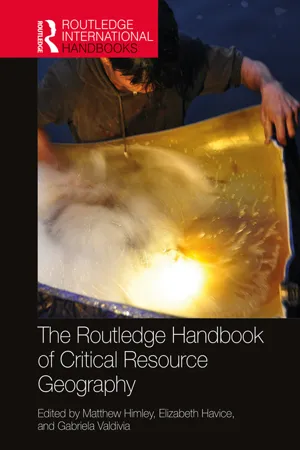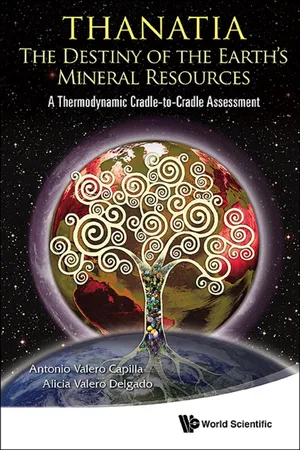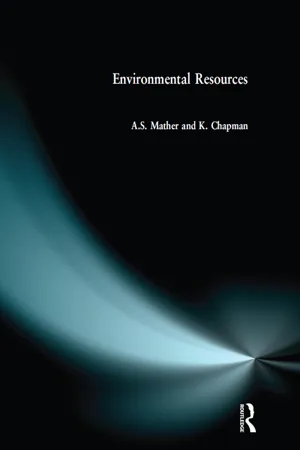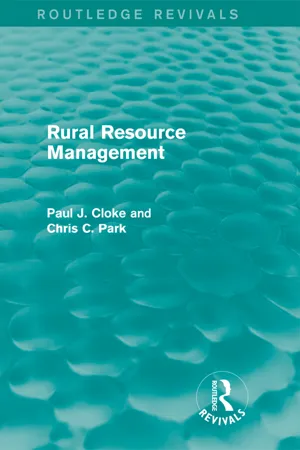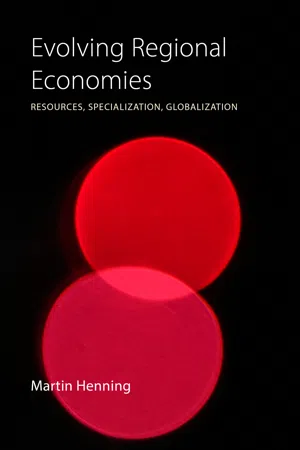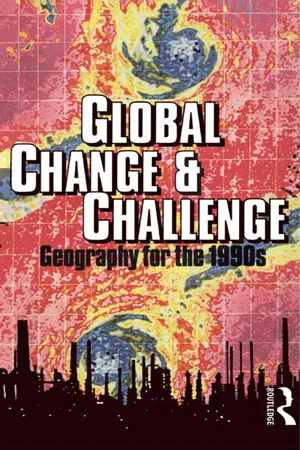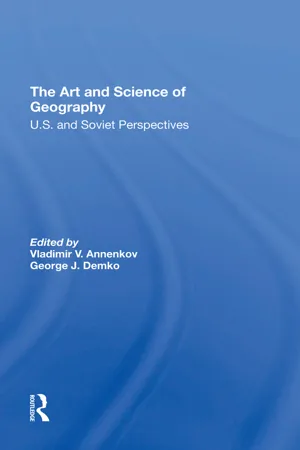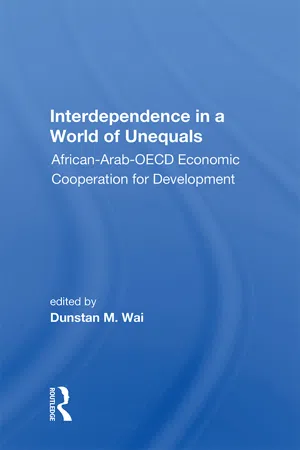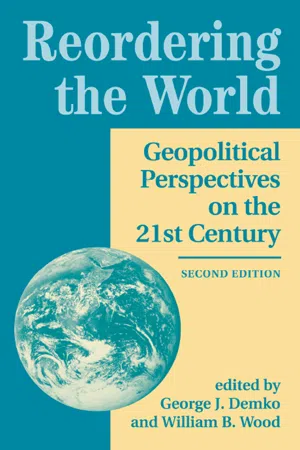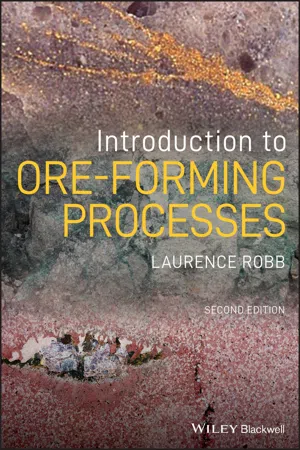Geography
Resources on Earth
Resources on Earth refer to the various materials and substances that are naturally occurring and can be used by humans for various purposes. These resources include water, minerals, forests, and energy sources such as oil and natural gas. They are essential for sustaining life and supporting human activities, and their availability and distribution have significant impacts on human societies and the environment.
Written by Perlego with AI-assistance
Related key terms
11 Key excerpts on "Resources on Earth"
- Matthew Himley, Elizabeth Havice, Gabriela Valdivia, Matthew Himley, Elizabeth Havice, Gabriela Valdivia(Authors)
- 2021(Publication Date)
- Routledge(Publisher)
1Critical resource geography
An introduction Gabriela Valdivia, Matthew Himley, and Elizabeth HaviceIntroduction
This Handbook is about the state of knowledge of one of geography's most cherished objects of study: resources. Resources can encompass a broad range of things, including, but not limited to, physical entities that are regularly disentangled from their existing relations and incorporated as parts or fragments within other sets of relations, in order to fulfill a promise. Resources, for example, are often thought of as means to an end, instruments to realize a goal or state, such as a life free of suffering or a “higher” level of socioeconomic development. Think of hydrocarbons extracted from the underground and refined to generate energy, or guano harvested from island ecosystems to fertilize depleted soils, or tuna captured from the oceans to meet food market demands. But resources, and the promises that they are expected to fulfill, are not simple or straightforward. Resources require systems of “resource-making” (Kama 2020; Li 2014; Richardson and Weszkalnys 2014), each with its own infrastructures, logics, temporalities, and valuation systems. Removing something from its existing relations in order to incorporate it as a resource into a new set of relations requires thought and action, all based on architectures of valuation through which some things and relations are rationalized as more valuable than others. This, in turn, raises questions about who is making these value judgments, in what context these valuations make sense and become dominant, and how systems of resource-making affect different constituencies in varied and uneven ways.The systems through which resources are made and circulated have compounding effects, shaping the world and how people experience and know it. The idea for this Handbook emerged in the context of an expansion of “critical” resource-centered scholarship examining the relationship between resource systems and the uneven worlds they create (see, for example, Bakker and Bridge 2006; Bridge 2009; Furlong and Norman 2015; Huber 2018; Lawhon and Murphy 2012; Kama 2020; Robbins 2002). Broadly, this research coheres around three key elements: an approach that positions the resource itself as the analytical starting point; an emphasis on the interrelated materiality and spatiality of resources and resource systems; and a concern for unequal power relations, distributive outcomes, and the ethical dimensions of these systems. Thematically, the focus is often on the capitalist production, distribution, and consumption of “established” resources—that is, entities whose identities as resources are relatively well-consolidated (e.g., copper, oil, tuna)—as well as the emergence of new socio-spatial “frontiers” for these, as seen, for instance, in the march of hydrocarbon and mineral-mining operations offshore and into deeper waters. Scholars also examine how an increasing array of things-in-the-world are abstracted, monetized, and incorporated into social life as “novel” resources or in resource-like ways: things such as human tissues, wildlife, parasites, and ecosystem services. Across this body of scholarship, researchers are attentive to the contestations and crises—from climate change to species extinction to toxic contamination—that are generated by dominant (i.e., capitalist) modes of resource production, consumption, management, and disposal. And scholars are increasingly interested in resource futures (e.g., green transitions and degrowth) as well as worlds that exist (or might exist) without or against the notion of resources.- eBook - ePub
Thanatia: The Destiny Of The Earth's Mineral Resources - A Thermodynamic Cradle-to-cradle Assessment
A Thermodynamic Cradle-to-Cradle Assessment
- Antonio Valero Capilla, Alicia Valero Delgado(Authors)
- 2014(Publication Date)
- WSPC(Publisher)
Chapter 6 The Resources of the Earth 6.1 IntroductionIn this chapter, a deeper look at the Earth’s components deemed useful to Man is undertaken. Consequently, a revision of energy and non-energy resources is carried out. This information will serve in a later chapter for assessing the exergy of the main Resources on Earth. Energy resources have been divided into energy originating from the solid Earth i.e. nuclear and geothermal; tidal; and that derived from the sun, including solar, hydroelectricity, wind, biomass and hydrocarbons. After a general description of each, it shows all of the potentially available resources that Nature provides, those which could be effectively obtained using technology into the near future and those which are used today. In addition, mineral resources are studied, highlighting their abundance and average crustal concentration.6.2 Natural resources: definition, classification and early assessmentsA natural resource can be defined as any form of matter or energy obtained from the environment that meets a human need. Therefore water, air, oil, biomass or minerals are classified as such. Natural resources are frequently categorised as renewable or non-renewable. The former are defined as those that are regenerated within a human time scale. Examples include hydro, biomass or solar energy. On the contrary, the latter can be considered a stock that has a regeneration rate of zero over a relatively long period as is the case of minerals (Lujula, 2003).Minerals can be further classified as fuel and non-fuel resources. Fuel resources are those from which energy can be potentially extracted i.e. coal, oil, natural gas or uranium. Non-fuel minerals include metals and industrial minerals.An early assessment of the renewable and non-renewable energy Resources on Earth was undertaken by Hall et al. (1987) and can be seen in Table 6.1 - eBook - ePub
- A.S. Mather, K. Chapman(Authors)
- 2018(Publication Date)
- Routledge(Publisher)
CHAPTER 3 Environmental resources in space and timeThe control of environmental resources and the means of exchange of resource products were discussed in Chapter 2 . This chapter reviews the equally important questions of how resources are distributed in space and how they have been perceived and utilized through time. It is concerned with the wheres and whens of environmental resources, and in particular with how these are inter-related.To state the obvious, the global physical environment is far from uniform. Climate, soil type and terrain all vary greatly over the Earth’s surface. The distribution of the human population, and of the demand for environmental resources, is also highly variable. In addition, as Chapter 1 suggests, different attitudes to the environment exist in different parts of the world. This chapter shows that these factors have changed over time, at least in many parts of the world. It also highlights the significance of what has been described as the ‘conquest of space’: easier and cheaper forms of transport have combined with political and economic imperatives to transform the spatial scale of resource use. In the past, people could usually look only to local environments for resources, but today world-wide systems of supply exist for many resource products. Whereas we were once ‘ecosystem people’, dependent on what could be obtained from the local ecosystem, now we are ‘biosphere people’, drawing resources from around the world (Dasmann, 1988). The use of environmental resources is therefore carried out within a changing framework of space and time. An understanding of how this framework has evolved is essential to the understanding of modern issues and problems in the management of environmental resources.Spatial characteristics of environmental resources
A spatial classification of resources
Some environmental resources are strongly localized, while others are widespread or even ubiquitous. The atmosphere and its oxygen are literally ubiquitous, while the ocean is very widespread and land is extensive. These spatial characteristics provide the basis for a simple classification of resources. Ubiquities occur everywhere, while commonalities occur in many and widespread areas. The atmosphere is an example of the former, and arable land or forests of the latter. On the other hand, rarities are strongly localized, occurring only in a few (usually small) areas. Some mineral deposits are among the best examples of resource rarities. In a few cases, they may amount to uniquities, occurring at only one point. - eBook - ePub
- Paul Cloke, Chris C. Park, Paul Cloke, Chris C. Park(Authors)
- 2013(Publication Date)
- Routledge(Publisher)
‘include all living things that have the capacity for reproduction and growth. As long as the rate of use is less than their rate of regeneration, and as long as their environments are kept suitable, they will go on replacing themselves. However, living communities are not necessarily renewable, if the way in which we use them is destructive. No living species can survive if we crop it at a rate more rapid than it can reproduce, or if we destroy the habitat in which it depends’.INEXHAUSTIBLE RESOURCES‘those such as sunlight, which will continue to pour onto the earth as long as humanity will be around, whether we use it in certain ways or not’. Other examples include water resources on the world scale.Thus developed countries can afford more readily to devote attention, resources and finances to planning the wise use of non-utilitarian resources than their less privileged developing counterparts; and it is also more convenient for the developed countries to adopt such a humanitarian approach to physical planning at the present time than it was in past times during their development process because of their better material standards of living at the present time. Whether the present period of economic recession forces a change in attitude towards non-utilitarian resources in countries such as Great Britain and the United States will only become apparent in the distant future.This book adopts a broader basis of designating ‘resources’ than is more commonly used, in examining both natural and human resources. People are a basic ingredient of the rural resource system and they must be considered in context. Natural resources are introduced in Chapter 3 , and human resources in Chapter 5 . Landscape resources, which represent the interface between Natural and Human Resources, are introduced in Chapter 4 .2.5 THE RURAL RESOURCE SYSTEMAshford19 - eBook - ePub
Evolving Regional Economies
Resources, Specialization, Globalization
- Martin Henning(Author)
- 2022(Publication Date)
- Agenda Publishing(Publisher)
As inferred the previous section, most resources are linked to space. Economic activities take place in particular localities for a reason. One of these reasons is access to resources. Just from looking at a map or thinking about geography, it is apparent that the resource endowment, or resource repertoire, varies across different locations. Different regions offer very different resources. Some locations have an abundance of certain resources while they are completely absent elsewhere. In the earliest eras of economic geography that focused around empirical description, mapping the presence of resources in different places was a key disciplinary objective.However, looking more closely and more conceptually at this issue, one finds that resources link to space to different extents. Some resources are completely bound to a place and cannot be easily moved whereas others can. A few resources are found almost everywhere: there is no particular source. Traditional Weberian location theory developed a couple of useful stylized concepts around this (Weber 1909 ). It says that inputs (resources) are either localized (accessible at a given point on the map) or ubiquitous (accessible everywhere at the same cost).The fact that a resource is “localized” does not mean that it is unique to one specific place. It could actually be available from several different sites. A good example is iron ore. It is a localized resource, but there is not just one mine on earth. In reality, most resources are localized to some extent (accessible at a given point on the map), but many of them, like iron ore, can also be moved or transported to other regions, although this incurs a cost. A localized resource has a source, and there is a cost to moving it or accessing it from distant locations. Iron ore has therefore one key characteristic that it shares with other localized resources: the cost of accessing it can be assumed to vary across space.In this sense, we can think of space – geographical distance – as a friction that limits access to localized resources. Regions have different resource repertoires because: (1) most resources are localized (having identifiable geographical sources); and (2) there is a cost to moving most resources or accessing resources from outside their locations. - eBook - ePub
Global Change and Challenge
Geography for the 1990s
- Robert Bennett, Robert Estall(Authors)
- 2012(Publication Date)
- Routledge(Publisher)
Disruption of essential biogeographical cycles (e.g. the carbon dioxide cycle and the greenhouse effect) threatening sustainability of life on earth; 2 Pollution loads exceeding the ‘absorptive’ capacity of the environment causing economic, health and amenity problems; 3 Loss of plant and animal species and landscape values, with wide, but poorly understood, long-term consequences. causes common to them all, nor is there a single appropriate policy response.THE NATURE OF RESOURCES
We must understand the term ‘resources’ and classify them before we can discuss the various problems arising from potential scarcity and evaluate the threats they pose.Natural resources are those products or properties of the physical environment which human beings are technically capable of utilising and which provide desired goods and services. Both these criteria must be satisfied before a particular part of the physicalworld can acquire a value as a resource. Technological innovation and improved knowledge only create the opportunities for utilisation. Whether these opportunities are taken up depends upon economic, social and political demands. Resources are, therefore, defined by human desires, needs and capacity. They are phenomena which depend greatly on the prevailing culture. This helps to explain the many disagreements over which particular elements in the environment are resources.Just as it is difficult to define what resources are, so the task of assessing whether future supplies will be adequate is also highly complex. We have not only to evaluate the capacity of the world to sustain adequate resource supplies over time, but we must also assess the extent to which human intervention (intended or unintended) will act to change those supplies. In addition we must try to predict which particular resources will be judged to have value by future generations.As human societies have evolved so has the definition of otentially usable resources. Today's list vastly exceeds that of Stone Age economies. Inevitably, too, reappraisal will continue in the future. Innovations and changes in life style will continue to change natural substances or environmental properties from ‘neutral stuff’ into valued resources. It must be stressed that this transfer process is not one-way. Just as flint lost value when metal tools were developed, so copper, coal, tin or uranium could all lose value, or revert to neutral stuff, if more effective or lower cost substitutes are found, or if consumer tastes change. It may be, for example, that the risks of radiation could eventually become so politically unacceptable that nuclear power generation will be phased out and uranium will lose the resource value it acquired in the 1940s, when atomic energy was first harnessed. - eBook - ePub
The Art And Science Of Geography
U.s. And Soviet Perspectives
- Vladimir V. Annenkov, George J Demko(Authors)
- 2019(Publication Date)
- Routledge(Publisher)
Soviet and American geographers, addressing the question of more rational use of natural resources on the earth, agree that their research and views can be very useful and productive. They suggest that geography's man-environment research traditions, sensitivity to the interdependence of regional systems at all scales, and geographers' spatial data systems are invaluable inputs for resource study and planning at international levels. Soviet colleagues describe a number of specific research areas relating to energy and other resources for geographers.Brunn (USA): The concerns of geographers for the preservation of the environment and a more rational use of natural resources can be expressed in three areas. First is the long-standing human-land (or sometimes called man-land) tradition. In this paradigm, which is subscribed to by most cultural geographers, there are concerns about human use and misuse of the earth, human modification of the earth's natural environment (climates, land form surfaces, vegetation, and soils), and the conservation of planetary, natural, biological, and human resources. The schools of cultural ecology, cultural adaptation, and landscape modification are expressly concerned with furthering our understanding of the human-land ties in traditional and contemporary societies in both developed and developing countries.The second area of study that is associated with environmental preservation and natural resource issues is that of humanistic geographers. To these geographers the concerns are the values that societies attach to land, the experiences that individuals and cultures have with land, and the meanings of land, landscape, and environment to a culture's religion, patterns of economic livelihood, and prevailing ethics as reflected in laws and regulations protecting the earth's resources. Geographers interested in these questions may find the human expressions of nature, environment, and human relations with the environment addressed in art, music, and theater, as well as in a culture's religion, philosophy, and leisure pursuits. Related work by anthropologists, historians, philosophers, and literary critics will be sought by humanistic geographers. The third area of study includes those geographers interested in social geography, broadly defined, and in particular with public policy and social welfare questions. Included under this rubric are concerns about geographers responding to contemporary social issues and current problems. Environmental conservation, the preservation of the planet's species, prudent use of natural resources, and the future of biosphere are major concerns of many social and political geographers. Their methodologies may be descriptive, analytical, or prescriptive (forecasting) and may include examining the above problem at a local or global scale. These studies draw support from related work by resource economists, biologists, political scientists, environmental psychologists, and social-environmental engineers. - eBook - ePub
Interdependence in a World of Unequals
African-arab-oecd Economic Cooperation For Development
- Dunstan M. Wai(Author)
- 2019(Publication Date)
- Routledge(Publisher)
This second category of manmade resources is particularly difficult to inventory. Thus it is difficult to define the resource potential of any area of the world because technology and research and development can work miracles on natural resources. To avoid these problems this chapter will concentrate on analyzing the natural resource base of sub-Saharan Africa with only a few remarks suggesting the potential for its improvement. Within the limits of available data, the extent to which these natural resources have been exploited will be presented. Lack of manmade resources will be found in many cases to be the crucial bottleneck in the full utilization of natural resources. It would be useful to identify which of these resources constitute "economic reserves," that portion of the resource that can be economically and legally utilized under present economic, technological, and legal circumstances. The determination of reserves would require extensive studies on a national and a continental scale. Such studies should ideally follow a rough mapping of the type undertaken in this study and should be done on a country, sectoral, industrial, and project basis. Indeed, this will be the next phase when it comes to tightening African-Arab-OECD cooperation, when the partners in the game choose to act for economic or noneconomic imperatives.This chapter is divided into three main parts: First I present the natural resource base and discuss how and to what extent it has been utilized so far in the production process. Land resources are discussed in terms of how they are utilized in the production of food and nonfood crops and in livestock production. Then the forestry, fisheries, water, and mineral resource areas are discussed with respect to the wood industry's output, fishing, hydroelectric and other kinds of power production, and mineral exploitation. The focus is on existing and potential local and external markets. Next, I discuss the development priorities and identify the major constraints on the full utilization of the available resources. Finally, I suggest the possible areas and forms that African-Arab-OECD cooperation should aim at under the prevailing circumstances.Natural Resources
Land Resources
It is important to know the quantity and quality of the land resource base in order to judge the adequacy of its utilization and to determine its potential usefulness. Knowing the vegetation and the ecology of the land resources helps us understand the nature and potential of agricultural and livestock production. Soil texture and depth determine nutrient availability and water storage capacity of the land resource. Rainfall, humidity, and air movements are the primary factors of climate that influence vegetation, plant growth, and livestock production. - eBook - ePub
Reordering The World
Geopolitical Perspectives On The 21st Century
- George J Demko(Author)
- 2018(Publication Date)
- Routledge(Publisher)
10Sustainable development has become an all-encompassing term for environmentally sound economic policies. Everyone lauds it as a goal, but achieving that idealized state is increasingly difficult. Governments face determined political pressure to encourage short-term economic returns over long-term sound resource management. Increasing numbers of young people in poor countries mean immediate demands for jobs, affordable housing, cheap food, public transport, urban infrastructure, and so on. In addition, decisions about use of national resource assets are often far from equitable; influential groups who control disproportionate amounts of a country’s natural resource (private or public sector) have often been inclined to reap high profits now and worry about long-term environmental consequences later, much later. Finally, natural resources have traditionally been designated as either a “free” asset or seriously undervalued by economists and lending institutions, resulting in blatant resource waste, poor supervision of resource exports, and serious environmental contamination at extraction sites (see Chapter 9 ). Such conditions do not lend themselves to sustainable development implementation.Environmentally Sound DevelopmentGovernments and international development organizations have recently begun to acknowledge the shortsightedness of policies that encourage uncontrolled resource exploitation. Apart from the international spotlight of the 1992 UN Conference on Environment and Development in Rio de Janeiro, there have been numerous global and regional fora focused on the dilemma of reconciling economic growth with environmental protection. The World Bank, bastion of prudent macroeconomics and past sponsor of mega-development projects, now argues that governments must rethink how they value their natural and human resources and, furthermore, orient their economic development policies around these reconfigured “national accounts.” Likewise, the U.S. Agency for International Development’s explicit mission is the promotion of sustainable development, as is that of the UN Development Programme. - eBook - ePub
Economic Growth
International Edition
- David N. Weil(Author)
- 2016(Publication Date)
- Routledge(Publisher)
The roles of resource prices and property rights are particularly relevant when we examine how economic growth affects the environment. The key difference between a clean environment and other natural resources is that most of the time, no one owns a clean environment, so no market price is attached to creating pollution. For this reason, environmental degradation—particularly for the aspects of the environment that are least subject to property rights, such as the atmosphere—is more likely to be a problem associated with economic growth than is a shortage of natural resources.
We begin by examining the different forms of natural resources, their measurement, and their use in economic activity.NATURAL RESOURCE CONCEPTS16.1Nonrenewable Resources
A nonrenewable resource is one that exists in a fixed quantity on the earth. When a nonrenewable resource is consumed, it is gone forever. A common measure of the availability of a nonrenewable resource is the level of current reserves, or the known quantity of the resource that can profitably be extracted at current prices using existing technology. Changes in the quantity of current reserves are brought about through four processes. The first two of these are the obvious ones: discoveries of new stocks of the resource raise reserves and depletion of existing stocks lowers reserves. The third way in which reserves can change is when the price of the resource changes: for example, if the price rises, then known deposits that were previously not worth extracting can become economically viable, increasing reserves. Finally, changes in technology can also make it worthwhile to extract a resource from a known deposit, even if the resource’s price has not changed. In recent years, an important example of this effect has been the development of hydraulic fracturing (“fracking”), a technique that allows for the recovery of natural gas and oil from deep shale formations.To look in more detail at data for a nonrenewable resource, we examine the most important one in the world today: oil. In 2011, oil accounted for 33% world energy production, followed by coal (28%), natural gas (22%), renewables (11%), and nuclear (5%).1 - eBook - ePub
- Laurence Robb(Author)
- 2020(Publication Date)
- Wiley-Blackwell(Publisher)
Introduction: Mineral Resources
Topics
General introduction and aims of the book A simple classification scheme for mineral deposits Some important definitions- metallogeny, syngenetic, epigenetic, mesothermal, epithermal, supergene, hypogene, etc.
- periodic table of the elements
- tables of the main ore and gangue minerals
- geological time scale
- enrichment factors required to make ore deposits
- how are mineral resources and ore reserves defined?
- sustainability
- environmental responsibility
Introduction and Aims
With a global population in 2019 of close to eight billion people, and this figure set to increase to some ten billion by 2050, it is apparent that the world's economies are under growing pressure to meet the demands of an increasingly materialistic lifestyle. The unprecedented growth of human population over the past century has resulted in a dramatic increase in demand for, and production of, natural resources – it is therefore evident that understanding the nature, origin, and distribution of the world's mineral deposits remains a vital and strategic topic. The discipline of “economic geology,” which covers all aspects pertaining to the description and understanding of mineral resources, is, therefore, one which traditionally has been, and should remain, a core component of the university earth science curriculum. It is also the discipline that underpins the training of professional earth scientists working in the minerals and related industries of the world. Unfortunately, a tendency at many universities in the recent past has been to treat economic geology as a vocational topic, and to provide instruction only to those individuals who wished to specialize in the discipline or to follow a career in the minerals industry. There has been a trend, at least in many parts of the world, to sideline economic geology both as a taught discipline and a research topic.
Index pages curate the most relevant extracts from our library of academic textbooks. They’ve been created using an in-house natural language model (NLM), each adding context and meaning to key research topics.
